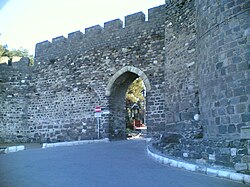Kadifekale
You can help expand this article with text translated from the corresponding article in Turkish. (November 2020) Click [show] for important translation instructions.
|
This article needs additional citations for verification. (November 2010) |
| Kadifekale | |
|---|---|
| İzmir in Turkey | |
 Entry of the castle walls in Kadifekale | |
| Coordinates | 38°24′50″N 27°08′45″E / 38.41389°N 27.14583°E |
| Type | Hilltop castle |
| Height | 35 metres (115 ft) |
| Site information | |
| Open to the public | Yes |
| Site history | |
| Built | 3rd century BC |
| Materials | Stone |
Kadifekale (literally "the velvet castle" in Turkish) is a hilltop castle in İzmir, Turkey. The castle is located on the Mount Pagos (Greek: Πάγος, Pagus under the Roman Empire) which has an elevation of 186 metres. It was built in the 3rd century BC.[1] The castle is located at a distance of about 2 km from the shoreline and commands a general view of a large part of the city of İzmir, as well as of the Gulf of İzmir.
In 2007, the metropolitan municipality of İzmir started renovation and restoration works in Kadifekale. In 2020, Kadifekale became a
Re-foundation of Smyrna on Mount Pagos
The first recorded defensive walls built here was the work of
Three and four times happy shall those men be hereafter, who shall dwell on Pagus beyond the sacred Meles.
While Alexander could only act as inspirator and/or initiator for the move, the recent excavations in Old Smyrna have shown that the settlement there could have ceased even during his lifetime. The legend, in the meantime, was frequently depicted on ancient coins.
Tale of Two Cities
The present walls are medieval. A number of sources put forth claims on having observed fragments of Hellenic masonry under the existing walls, but these fell short of having acquired general acceptance. The long hollow west of the castle marks the site of the Stadium, scene of the martyrdom of
Next to the castle are the ruins of the cisterns built during the Roman period and renovated during the Byzantine and Ottoman periods. They formed the centre of the drinking water network of Smyrna. The remains of this network are still preserved in the agora of Smyrna in downtown İzmir.
Cultural activity
In 2015 the Barış Youth Symphony Orchestra was founded incorporating children with limited opportunities with the purpose to keep them away from crime on the street existing in the neighborhood. The orchestra, grown up to nearly one hundred members coming also from other neighbors of the city, gives concerts accompanied by notable classic music artists.[3]
Gallery
-
Cisterns
-
Castle gate
-
Watch tower
-
Castle wall
Footnotes
- ^ "Kadifekale" (in Turkish). Türkiye Kültür Portalı. Retrieved 8 July 2020.
- ^ "The Historical Port City of Izmir". UNESCO. Retrieved 16 April 2020.
- NTV(in Turkish). 1 May 2022. Retrieved 29 January 2023.
Books
- ISBN 0-7103-0776-4.
- Bean, George E. (1967). Aegean Turkey: An Archaeological Guide. London: Ernest Benn. ISBN 978-0-510-03200-5.
- Cadoux, Cecil John (1938). Ancient Smyrna: A History of the City from the Earliest Times to 324 A.D. Blackwell Publishing.
External links
- Images of Kadifekale at wowturkey.com
- A. Karayiğit (July 2005). "Kadifekale'nin sosyo-ekonomik profili ve sorunları" [Kadifekale's socio-economic profile and problems] (PDF) (in Turkish). İzmir Chamber of Commerce. Archived from the original (PDF) on 2018-12-20. Retrieved 2018-12-20.







